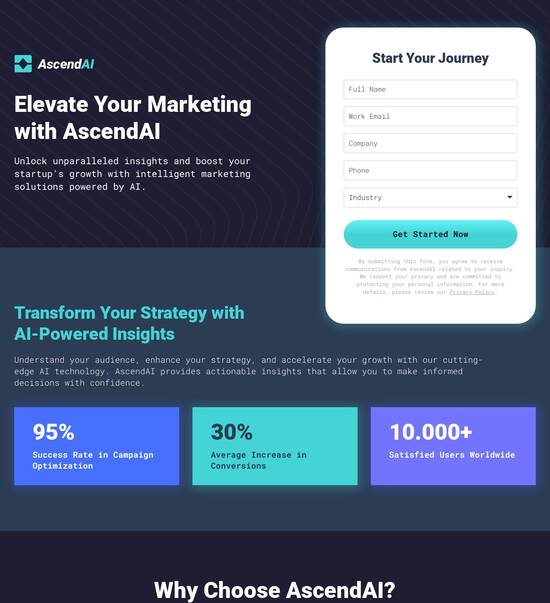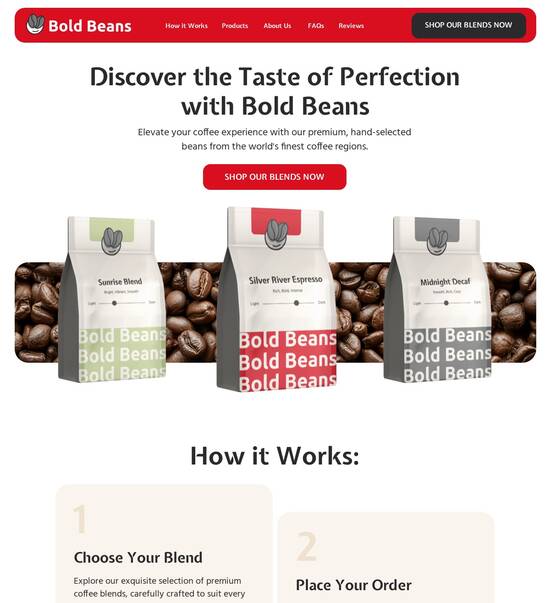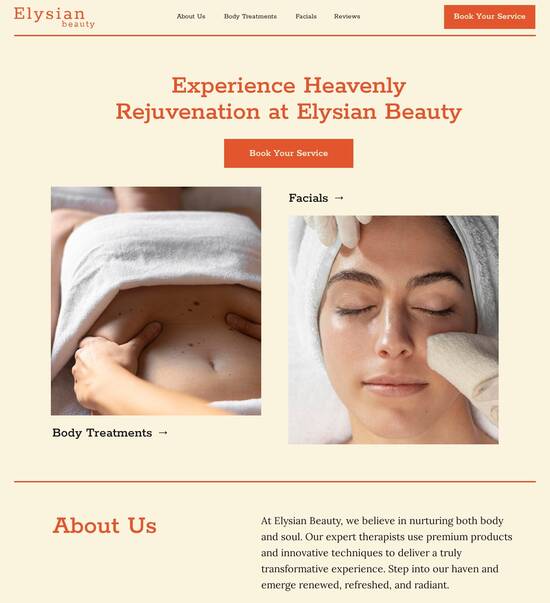
Minimalist weather forecast website template
Explore Similar TemplatesAbout template
Drive more leads with Instapage minimalist weather forecast website template built to maximize conversions. Easy customization - no designer or coding skills needed.
Recommended templates

Easy to build without coding
With the intuitive drag-and-drop builder, anyone on your team can create high-converting pages without any knowledge of code or design. Make enhancements to your landing page with custom widgets using Javascript, HTML/CSS, or third-party scripts.

Multiple layouts for any industry and goal
Select from 500+ landing page layouts built to boost conversions across industry-specific scenarios. Customize them by adjusting fonts, adding images, and generating on-brand content with the AI assistant. Quickly scale with Instablocks® and Global Blocks that you can save, reuse, and update globally.

Loads fast and looks polished on any device
Every template is responsive, which means they present professionally on any device and load blazingly fast with our Thor Render Engine. You can also power them up with Google AMP technology to deliver an unparalleled mobile experience and drive higher conversions.

Robust analytics & experimentation
Get real-time updates and reporting across all your devices, showing the number of visitors, conversions, cost-per-visitor, and cost-per-lead. Launch AI-powered experiments, run A/B tests, and use heatmaps to analyze user behavior, then optimize your landing page to maximize conversions.







Easy to build without coding
With the intuitive drag-and-drop builder, anyone on your team can create high-converting pages without any knowledge of code or design. Make enhancements to your landing page with custom widgets using Javascript, HTML/CSS, or third-party scripts.
Multiple layouts for any industry and goal
Select from 500+ landing page layouts built to boost conversions across industry-specific scenarios. Customize them by adjusting fonts, adding images, and generating on-brand content with the AI assistant. Quickly scale with Instablocks® and Global Blocks that you can save, reuse, and update globally.
Loads fast and looks polished on any device
Every template is responsive, which means they present professionally on any device and load blazingly fast with our Thor Render Engine.
Robust analytics & experimentation
Get real-time updates and reporting across all your devices, showing the number of visitors, conversions, cost-per-visitor, and cost-per-lead. Launch AI-powered experiments, run A/B tests, and use heatmaps to analyze user behavior, then optimize your landing page to maximize conversions.
All the features you need to build lead-generating landing pages
Explore more featuresLearn how to build top-performing landing pages for any goal
FAQs
Leading the way in building high-performing landing pages





Maximize Your Campaigns with Instapage's Powerful Landing Page Platform
Instapage offers marketers a robust landing page and conversion rate optimization (CRO) platform, designed to boost campaign performance and drive ROI, no matter your team size or budget. This guide provides a comprehensive step-by-step approach to harnessing the full potential of Instapage for your digital marketing efforts.
Step 1: Understanding the Importance of Landing Pages
Landing pages are crucial for capturing leads and converting visitors into customers. By utilizing Instapage’s customizable templates, marketers can ensure their pages are optimized to speak directly to their audience's needs.
- Tailored Templates: Create bespoke pages using over 100 templates catered to various industries.
- Lead Gen Elements: Integrate pre-built elements that simplify the data capture process.
- Optimization Tools: Leverage built-in experimentation tools to test and refine landing page effectiveness.
Step 2: Create High-Converting Landing Pages
Building high-converting landing pages is simple with Instapage. Use flexible page builders that require no coding experience, making it accessible to any marketer.
- Drag-and-Drop Functionality: Effortlessly place elements where you want them without coding.
- Library of Layouts: Choose from conversion-focused layouts to optimize for higher engagement.
- Instablocks: Utilize reusable sections to streamline the creation process across multiple pages.
Step 3: Optimize and A/B Test Your Pages
Optimization is key to maximizing conversions. Instapage’s tools enable users to test different versions of their landing pages seamlessly.
- Heatmaps: Visualize user behavior on your page to identify better-performing content.
- A/B Testing: Run split tests to compare two versions of a page and find out which converts better.
- Analytics Dashboard: Access comprehensive data to review performance metrics and refine strategies.
By following these steps, marketers can not only create effective landing pages but also ensure that these pages continuously evolve and improve based on data-driven insights.
Don't just settle for standard landing pages; elevate your marketing strategy with Instapage. Start creating and optimizing your campaigns today for maximum impact.
Minimalist weather forecast website template: design for clarity and functionality
The aesthetic allure of minimalism: a design philosophy for weather forecast websites
The minimalist design philosophy brings a refreshing clarity and focus to weather forecast websites. In a world where information overload can lead to confusion, a streamlined approach enhances user experience significantly. By emphasizing simplicity, minimalist design allows users to quickly grasp essential weather updates without unnecessary distractions.
Defining minimalism in digital design
Minimalism in digital design revolves around core principles that prioritize simplicity and clarity. This approach encourages designers to reduce clutter by focusing exclusively on essential elements, which not only elevates aesthetic appeal but also boosts functionality.
1.1. Core principles of minimalism: - Simplicity and clarity: Simplifying the design aids user comprehension. - Reduction of clutter: Removing excess elements helps maintain focus on critical information. - Focus on essential content: Prioritizing content ensures users find what they need effortlessly.
1.2. The importance of user experience (UX) in minimalist design: - Enhancing user engagement: A clean layout encourages users to stay longer on the site. - Navigational ease: Streamlined navigation minimizes the time spent searching for information.
Essential features of a minimalist weather forecast website template
When it comes to minimalist weather forecast websites, essential features create an easy-to-use experience for site visitors. Streamlined layouts take center stage, focusing on white space and easy-to-read typography to ensure that information is both accessible and aesthetically pleasing.
2.1. Streamlined layouts: - Importance of white space: Generous white space around elements can improve readability and visual comfort. - Easy-to-read typography: Choosing legible fonts allows users to quickly digest information about weather forecasts.
2.2. Interactive elements contribute to user engagement: - Dynamic weather updates at your fingertips: A minimalist design should allow real-time weather updates without overwhelming users. - Intuitive dropdown menus for quick access: This seamless navigation enhances the user experience without cluttering the interface.
2.3. Mobile responsiveness: In an increasingly mobile world, ensuring that your website design adapts beautifully across various devices is vital. This guarantees that users have consistent access to weather information regardless of their screen size.
Key advantages of using a minimalist template
Opting for a minimalist weather forecast website template comes with multiple advantages that can significantly enhance user satisfaction and engagement.
3.1. Enhanced load speeds: - Reducing load times for better user satisfaction: A minimalist approach ensures faster loading times, which is crucial for retaining visitors. - Impact on SEO performance: Search engines favor fast-loading websites, improving visibility.
3.2. Boosting engagement and retention: - Lower drop-off rates: Simplistic navigation reduces frustrations, keeping users on the site longer. - Increasing interaction with weather data: Clear presentation encourages a deeper dive into weather statistics.
3.3. Building user confidence: - Transparent display of weather conditions: Clear design aids in easier interpretation of data. - Clear communication of terms and conditions: Transparency builds trust with your audience.
Creative customization capabilities
One of the appealing aspects of a minimalist weather forecast website template is the ability to customize it to resonate with your brand while preserving the minimalist essence. This plays a crucial role in establishing an identity within a saturated digital landscape.
4.1. Tailored color palettes: - Ensuring brand identity while maintaining minimalism: A thoughtful color palette can seamlessly reflect your brand's personality. - Emotional impact of colors on user perception: Colors evoke feelings; choosing them wisely encourages desired user reactions.
4.2. Font options and readability: - The psychology of typography in weather reporting: Fonts can shape perceptions; selecting appropriate weights and styles matters. - Best practices for font selection in minimalism: Use contrasting font sizes for headings and body text to drive attention.
Integrating e-commerce features
With the rise of online shopping, many weather forecast websites are integrating e-commerce functionalities, providing users with convenient shopping experiences aligned with the forecasts.
5.1. Displaying related products seamlessly: - Contextualizing products within weather forecasts: Suggesting relevant products like rain gear when forecasts predict inclement weather helps users prepare. - Example: Selling outdoor gear during rain forecasts could increase sales significantly.
5.2. Smooth cart functionality: - Integrating e-commerce without compromising aesthetic: A minimalist approach to e-commerce ensures the online shopping experience is uncomplicated and efficient. - User experience with a minimalist shopping flow: Clear call-to-action buttons guide users through the purchase process.
5.3. Emphasizing money-back guarantees: - Building trust through clear policies: Displaying guarantees can alleviate customer concerns about online purchases. - Placement for maximum visibility and reassurance: Strategically positioning guarantee messages enhances user comfort.
Categorization and collection features
A well-structured weather forecast website template must include effective categorization and collection features to provide users with coherent pathways to the information they seek.
6.1. Logical weather categories: - Differentiating between forecast types (e.g., daily, weekly): Users need straightforward navigation, allowing them to jump to the exact type of forecast they seek. - Customizing weather alerts for specific conditions: Tailored alerts improve user engagement by addressing individual needs.
6.2. Product collections based on weather patterns: - Forecast-driven product suggestions: Align product recommendations with the current weather to boost sales and enhance user experience. - Seasonal collections and thematic marketing strategies: Creating seasonal offerings encourages users to return for timely product updates.
Legal considerations and user rights
In a world where user rights and privacy concerns are paramount, ensuring your weather forecast website template incorporates robust legal considerations is essential.
7.1. Clearly stated privacy policies: - Importance of user data protection: Websites must protect user data meticulously to avoid potential breaches. - Key elements to include in a privacy policy: Include data collection practices, user rights, and contact information for inquiries.
7.2. Transparency in terms and conditions: - How well-defined terms enrich user trust: Clear, concise terms help demystify user expectations. - Providing easy access to these terms enhances user confidence and loyalty.
Projects and future trends in weather forecast website design
The field of weather forecast website design is evolving continuously, guided by new technologies and user preferences. Understanding recent trends helps designers stay ahead in the competitive landscape.
8.1. The evolution of minimalism in digital design: - Trends shaping the future of weather forecasting interfaces include simplified layouts and improved navigational structures that focus on user needs.
8.2. The role of AI and data analytics: - Predictive analytics enhances user experience by tailoring forecasts to user preferences; this personalized touch can build loyalty. - Tailoring weather forecasts to fit individual needs helps engage users in an increasingly dynamic online environment.
Practical steps for implementation
Implementing a minimalist weather forecast website begins with understanding the right template for your needs and customizing it to optimally serve your audience.
9.1. Selecting the right template: - Features to look for in a minimalist weather forecast template: Consider factors like responsiveness, clean design, and potential integration options for e-commerce.
9.2. Customizing for your audience: - Gathering user feedback for informed adjustments: Regularly seeking input allows for continuous improvement and ensures the site meets user expectations.
9.3. Launching and testing: - Metrics to evaluate the effectiveness of the website: Monitor user engagement, load times, and bounce rates to identify areas for improvement. - Continuous improvement based on user interactions fosters a culture of engagement and responsiveness.
The future of weather forecasting websites: innovative innovations
Weather forecasting websites are on the brink of exciting innovations that can enhance user engagement and experiences greatly.
10.1. Utilizing advanced technology for a superior user experience: - Integration of real-time data feeds allows for up-to-the-minute forecasts, enhancing relevance for users. - User interface enhancements through innovative tools make accessing information effortless.
10.2. The shift towards eco-friendly practices in design: - Sustainability in web design not only addresses user concerns but also aligns with environmental consciousness, enhancing your brand’s reputation. - Aligning website practices with eco-friendly principles can engage users who prioritize conscious consumerism.
Ready to skyrocket conversions?
Supercharge your ad campaigns with high-performing landing pages
Get started














